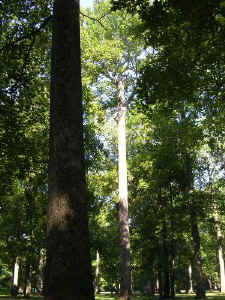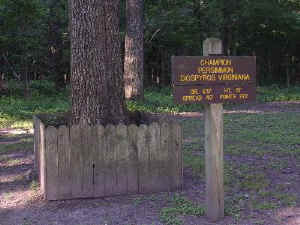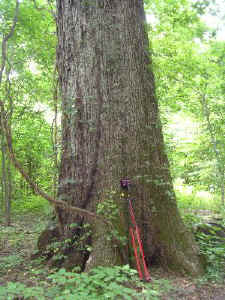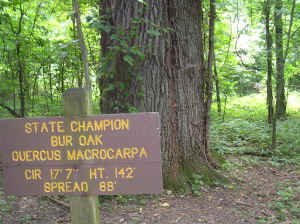I was able to make a trip on July 29 to Big Oak Tree State Park
in
Missouri. It turned out to be a glorious summer day (especially
for
late July in SE Missouri)--clear blue skies, low humidity,
temperatures
in the low 80s, and not too many bugs. A perfect day for
measuring big
trees!
According to their brochure, Big Oak Tree State Park was
set-aside for
protection in the 1930s when the state made a Depression-era
purchase of
slightly more than 1,000 acres of bottomland hardwood timber
from the
Mississippi Valley Hardwood Company. Most of the remaining
old-growth
was found in an 80-acre tract surrounding the "Big Oak
Tree," a 400 year
old bur oak (this oak died in 1952, but they have a
cross-section in the
interpretive center).
 Sweetgum, ht. 123.8 feet, cbh 12.7 feet
Sweetgum, ht. 123.8 feet, cbh 12.7 feet
The area is an island of mature forest in a heavily agricultural
portion
of southeastern Missouri. The site is relatively low and fairly
wet
during the winter and spring of the year, with decently good
Mississippi
Delta soils. The stands are hardwood-dominated, with the only
conifer
being baldcypress. The overstory is a diverse mixture of oaks,
cottonwoods, gums, hickories, ashes, etc., while the understory
is
dominated by low-stature trees/shrubs, cane, and woody vines
(e.g.,
pawpaw, giant cane, poison ivy, grape, etc.). I'm not very
familiar
with the multitudes of herbaceous understory species, but there
was at
least one species of nettle (I felt these very clearly).
With over 1,000 acres, there is a lot of ground to cover at this
state
park, and I only had about a 1/2 day to explore, so I stuck to
the main
trails and the more developed areas. Right as you enter the
park, there
is a mowed area with picnic tables and playground equipment
under a
towering canopy of oak, hickory, and sweetgum. This area was
open
enough to make for easy height measurements:
Picnic area DBH CBH
SineHT
Species (in.)
(ft) (ft) Comments
sweetgum 38.6 10.1
112.3
sweetgum 40.8 10.7
113.7
cow oak 43.0
11.3 120.0 a.k.a. swamp chestnut oak, or Quercus
michauxii
cow oak 32.9
8.6 109.2
persimmon 29.6 7.7
118.2 state champion
sweetgum 48.7 12.7
123.8
Am. elm 36.6
9.6 101.5
shellb hickory 26.7 7.0
117.7 shellbark hickory (Carya laciniosa)
cow oak 45.6
11.9 113.7
cow oak 39.0
10.2 117.1
Shumard oak 44.0 11.5 117.9
pumpkin ash 26.2 6.9
106.4
The persimmon was particularly impressive, given how few big
examples of
this species can be found.
 Persimmon, ht. 118.2 feet, cbh 7.7 feet
Persimmon, ht. 118.2 feet, cbh 7.7 feet
I then followed a trail from the
picnic area
to an impoundment on the property. Most of the trees listed
below were
right off of this trail, and I'm sure there are plenty of others
that I
missed that are also quite impressive:
Pond Trail DBH
CBH SineHT
Species (in.)
(ft) (ft) Comments
cow oak 54.0
14.1 111.9 DBH adjusted for vines
white ash 46.8
12.3 113.5
e. cottonwood 58.9 15.4 117.8
Populus deltoides
cherrybark oak 61.5 16.1 114.1
bur oak 57.5
15.1 107.0 DBH adjusted for vines
sugarberry 34.3
9.0 93.4
Shumard oak 37.5 9.8
112.9
possumhaw 3.4
0.9 ~15.0 Ilex decidua (state champion)
baldcypress 40.8 10.7
101.1
pawpaw 4.0
1.0 39.0
e. cottonwood 50.8 13.3
122.1
e. cottonwood 55.1 14.4
131.2
overcup oak 50.0 13.1
92.4
e. cottonwood 52.6 13.8
109.0
cow oak 80.0
20.9 115.8 bigger in diameter than my D-tape!!
The cow oak (a.k.a. swamp chestnut oak) was literally the
biggest
diameter oak I have every personally seen. Massive!
Unfortunately, it
has lost a large portion of its top in recent years to wind (or
ice) and
decay. The park brochure puts its DBH at 86.6 inches, although I
think
this value may include some vines...it was literally too big to
reach my
D-tape around, and is easily 80 inches in diameter. I threw in a
few of
the smaller dimensioned species especially for Will Blozan (I'm
sure
there are larger pawpaw in the park, this happened to be the
largest
convenient one). Many impressively large cottonwood along this
trail.
 Cow oak (Quercus
michauxii) ht. 118.5 feet, cbh 20.9 feet
Cow oak (Quercus
michauxii) ht. 118.5 feet, cbh 20.9 feet
The final section of park I traveled along was the boardwalk
area (which
was under construction). Several state champion trees along this
section, and the national champion pumpkin ash. This trail was
at the
end of my day, so I skipped to only the biggest of the trees
along about
half of the trail:
Pond Trail DBH CBH
SineHT
Species (in.)
(ft) (ft)
Comments
sycamore 36.7 9.6
126.4
bur oak 67.2
17.6 116.7 state champion
pumpkin ash 59.0 15.4 102.8 national champion
Shumard oak 50.0 13.1 122.6
 Bur Oak, ht. 116.7 feet, cbh 17.6 feet
Bur Oak, ht. 116.7 feet, cbh 17.6 feet
Note that the pumpkin ash is listed as the American Forests
national
champion at 150 feet tall when measured in 2003. Now, while it
is
possible that I did not measure the tallest of the leaders, I
did have a
pretty good shot at the crown, and would not have missed it by
almost 50
feet! This is a classic example of the problems of the tangent
method
when measuring large hardwoods--this individual had a widely
spreading
crown, and was almost certainly overestimated in height. The
list of
current and former champion trees listed on a billboard outside
the
exhibition hall also list 150+ foot heights for the big bur and
cow oaks
I have listed (also dramatic overestimates), and had the state
champion
persimmon at 133 feet (15 feet too tall). The stand's RI10 is a
better
reflection of the height of the canopy:
Species
SineHT
e. cottonwood 131.2
sycamore
126.4
sweetgum
123.8
Shumard oak 122.6
cow oak
120.0
persimmon 118.2
shellb hickory 117.7
bur oak
116.7
cherrybark oak 114.1
white ash
113.5
RUCKER INDEX 120.4
Given that this was a very quick trip over a small portion of
the state
park, sticking to trails and developed areas, I think this
Rucker Index
could go higher, perhaps 130+. I suspect the tallest of all of
these
species may reach 5 to 10 feet higher, and some of the
individual big
trees I looked at may actually have taller branches. The thick
hardwood
overstory and broadly spreading crowns frequently makes height
determination difficult in this stand. There are also a number
of
species that are out there that I did not measure at all (e.g.,
pecan,
several hickories, red maple), and others that only had one
individual
measured (e.g., shellbark hickory, baldcypress).
This easy-to-access and big tree-filled state park is well worth
a
visit, if you happen to be in this part of the world. I will
send Ed
some pictures I took of this park for the website.
Don Bragg
*****************
Don Bragg, Ph.D.
Research forester
*****************
|